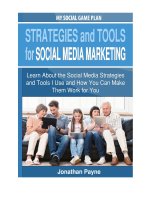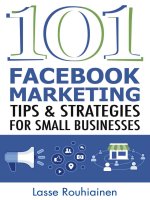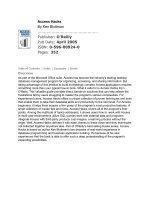Mind Hacks: Tips and Tools for Using Your Brain - Tom Stafford
Bạn đang xem bản rút gọn của tài liệu. Xem và tải ngay bản đầy đủ của tài liệu tại đây (4.6 MB, 1,044 trang )
Mind Hacks™: Tips &
Tools for Using Your
Brain
Tom Stafford
Matt Webb
Published by O’Reilly Media
Beijing ⋅ Cambridge ⋅ Farnham ⋅ Köln ⋅ Sebastopol ⋅
Tokyo
“What to do with too much information is the great
riddle of our time.”
—Theodore Zeldin, An Intimate History of
Humanity
Other resources from
O’Reilly
Related
titles
Google Hacks™
eBay Hacks™
TiVo Hacks™
Wireless Hacks™
Mac OS X Hacks™
Windows XP Hacks™
Linux Server Hacks™
Hacks
Series
Home
hacks.oreilly.com is a community site for
developers and power users of all stripes.
Readers learn from each other as they
share their favorite tips and tools for Mac
OS X, Linux, Google, Windows XP, and
more.
oreilly.com oreilly.com is more than a complete
catalog of O’Reilly books. You’ll also find
links to news, events, articles, weblogs,
sample chapters, and code examples.
oreillynet.com is the essential portal for
developers interested in open and
emerging technologies, including new
platforms, programming languages, and
operating systems.
Conferences O’Reilly brings diverse innovators
together to nurture the ideas that spark
revolutionary industries. We specialize in
documenting the latest tools and systems,
translating the innovator’s knowledge into
useful skills for those in the trenches.
Visit conferences.oreilly.com for our
upcoming events.
Safari Bookshelf ( safari.oreilly.com ) is
the premier online reference library for
programmers and IT professionals.
Conduct searches across more than 1,000
books. Subscribers can zero in on answers
to time-critical questions in a matter of
seconds. Read the books on your
Bookshelf from cover to cover or simply
flip to the page you need. Try it today with
a free trial.
Foreword
Few developments in the brain sciences over the
past 20 years have been as crucial as the steady
eradication of the brain-as-computer metaphor that
dominated so much of our thinking about thinking
in the ’60s and ’70s. Partly the metaphor declined
because artificial intelligence turned out to be a
vastly more complicated affair than we imagined;
partly it declined because we developed new tools
for understanding and visualizing the biology of the
brain, which didn’t look like a microprocessor
after all; partly it declined because an influential
group of scientists began exploring the vital role of
emotion in brain function. It’s true the brain
contains elements that resemble logic gates of
digital computing, and some influential researchers
continue to describe the activity of mind as a kind
of computation. But for the most part, we now
accept the premise that computers and brains are
two very different things that happen to share some
aptitudes: playing chess, say, or correcting
spelling.
At first glance, the book you’re holding in your
hand might be accused of reviving the old brain-
as-computer conceit: “hacks” is a software term,
after all, and the previous books in the series have
all revolved around digital computing in one form
or another. But I think this book belongs instead to
a distinctly 21st-century way of thinking about the
brain, one we might call—in the language of
software design—user-centric. The wonders of
brain science are no longer something we
contemplate exclusively in the lab or the lecture
hall; we now explore how the brain works by
doing experiments on our own heads. You can
explore the architecture and design of your brain
just by sampling the many exercises included in the
following pages. Consciousness exploration is an
old story, of course—one of the oldest—but
consciousness exploration with empirical science
as your guide is a new one. We’ve had the age of
Freud, of psychedelics, of meditation. This book
suggests that a new form of introspection is on the
rise, what I’ve called, in another context,
“recreational neuroscience.”
I think the idea of a brain hack is a wonderful one,
and Matt Webb and Tom Stafford have assembled
here a collection of tricks-of-the-mind that will
astound you, and give you a new appreciation for
the way your brain shapes the reality you perceive.
But it’s worth pointing out a subtle distinction
between the software use of the word “hack” and
the way Matt and Tom use it here. In programming,
a hack is something we do to an existing tool that
gives it some new aptitude that was not part of its
original feature set. When we hack a piece of code,
we are bending the software to fit our will; we’re
making it do something its original creators never
dreamed of.
The mind hacks that will delight and puzzle you in
the coming pages largely work in the opposite
direction. When you undergo these experiments,
what you’re sensing is not your brain’s
subservience to your will, but rather its weird
autonomy. These hacks amaze because they reveal
the brain’s hidden logic; they shed light on the
cheats and shortcuts and latent assumptions our
brains make about the world. Most of the time,
these mechanisms are invisible to us—or so
ubiquitous we no longer notice their existence. A
brain hack is a way of pulling back the curtain of
consciousness to glimpse—however fleetingly—
the machinery on the other side.
This can be a profoundly unsettling experience,
precisely because it reveals the way the brain is
not always subservient to your will, which very
quickly leads you down an existential slide.
(Whose will is it anyway?) But it’s a journey that
anyone interested in the mind cannot afford to miss.
Our brains have a kind of life of their own, quite
apart from what we think we know about
ourselves. That’s a scary thought, but being scary
doesn’t make it any less true. As you read through
the coming pages, you’ll no doubt find yourself
alarmed at the strange cognitive behavior you can
trigger just by following a simple set of
instructions. But I suspect you’ll also find yourself
with a new sense of wonder about the mystery of
consciousness—along with some killer cocktail
party tricks.
So that is the inward adventure that lies before
you. May it mess with your head in all the right
ways.
—Steven Johnson Brooklyn, New York
Steven Johnson is the author of Mind Wide Open:
Your Brain and the Neuroscience of Everyday
Life (Scribner).
Credits
About the Authors
Tom Stafford likes finding things out and writing
things down. Several years of doing this in the
Department of Psychology at the University of
Sheffield resulted in a Ph.D. Now sometimes he
tells people he’s a computational cognitive
neuroscientist and then talks excitedly about neural
networks. Lately he’s begun talking excitedly about
social networks too. As well as doing academic
research, he has worked freelance, writing and
working at the BBC as a documentary researcher.
Things he finds interesting he puts on his web site
at .
Matt Webb is an engineer and designer, splitting
his working life between R&D with BBC Radio &
Music Interactive and freelance projects in the
social software world. In the past, he’s made
collaborative online toys, written IM bots, and run
a fiction web site (archived at
); now he’s content
with hacky web scripts and his weblog,
Interconnected, at />. Matt reads a little too much, likes the word
“cyberspace,” lives in London, and tells his mother
he’s “in computers.”
Contributors
The following people contributed to this book:
Adrian Hon ( ) graduated from
the University of Cambridge with a degree in
natural sciences, specialising in neuroscience.
He has also researched synaesthesia with Prof.
V. S. Ramachandran at the University of
California, San Diego, and spent a year at the
University of Oxford researching integrative
physiology. In the past few years, Adrian has
been the cocreator of the NASA award-winning
web site Astrobiology: The Living Universe
and has spent 2 weeks in the Utah desert in a
simulation of a manned mission to Mars (during
which time he realised a long-held ambition of
wearing a spacesuit). More recently, Adrian
has developed a serious interest in alternate
reality games and is currently working on
Perplex City.
Alex Fradera (
) is a
psychology grad student at University College
London. He likes to make science seem like fun,
but all too often fun seems like science. No
matter. When not testing patients or writing
programs, he may be found fronting his band,
reading comics, or playing capoeira.
Andy Brown is currently reading for a Ph.D. in
developmental cognitive neuropsychology at the
University of Sheffield. He has an M.Phil. in
psychology (looking at cognitive impairment
following stroke) and has also spent 2 years as
a research assistant at University College
London looking at computer-based
interventions within primary care clinical
psychology. He is also a photographer (
).
Chris Bird () is a
researcher at the Institute of Cognitive
Neuroscience in London. He investigates the
effects of brain damage on cognition.
Dr. Christian Beresford Jarrett (
) is
writer/editor of the British Psychological
Society’s Research Digest (
),
research associate with the sensorimotor
neuroscience group at the University of
Manchester, and freelance editor for Trends in
Cognitive Sciences. He lives in West
Yorkshire.
Disa Sauter (
) is a
Ph.D. student at University College London.
She passionately researches emotional sounds,
the way in which we laugh, cry, cheer, and
grunt. When not in the office, Disa likes to
practice yoga and travel.
Dylan Evans ( ) is the
author of several popular science books,
including Emotion: The Science of Sentiment
(Oxford University Press) and Placebo: The
Belief Effect (HarperCollins). After receiving
his Ph.D. in philosophy from the London School
of Economics, he did postdoctoral research in
philosophy at Kings College London and in
robotics at the University of Bath before
moving to the University of the West of
England, where he is currently senior lecturer
in intelligent autonomous systems.
Ellen Poliakoff ( ch-
sci.manchester.ac.uk/staff/EllenPoliakoff ) is
a lecturer in psychology at the University of
Manchester and enjoys working somewhere
between psychology and neuroscience. In her
free time, she enjoys, among other things,
visiting stone circles and playing in a band (
).
Iain Price ( )
studied the neurosciences for his bachelor and
doctorate degrees at Cardiff University. He is
now pursuing science communication projects
in conjunction with his continued fascination
with the philosophies of the human mind.
Recently he has helped to develop and present
the BBC’s community outreach events to
accompany The Human Mind TV series (
).
Karen Bunday ( ) is
studying for a Ph.D. in movement and balance at
Imperial College London, having already
graduated with a B.Sc. in psychology from
Royal Holloway, University of London. She has
been published as a coauthor in the journal
Current Biology and is currently writing two
papers based on her own Ph.D. research for
future publication.
Michael Bach, Ph.D. (
), holds a
professorship in neurobiophysics, running the
section functional vision research in
ophthalmology, at the Medical School of the
University of Freiburg, Germany. He is happily
married and has three children. Professionally,
he provides electrodiagnostic services for
patients with eye diseases, and is interested in
basic and applied vision research, thus
covering both physiology and pathophysiology
of visual perception. His hobbies include
reading, swimming, programming optical
illusions, riding his recumbent bike, and in
winter snowboarding or skiing. His web site
demonstrates and explains many interesting
optical illusions and visual phenomena (
).
Mike Bywaters
Myles Jones is a lecturer in psychology at the
University of Sheffield (
). His main
research interest is understanding the
relationship between neuroimaging signals and
the underlying neural activity.
Nicol Spencer Harper is a CoMPLEX Ph.D.
student in the physiology department of
University College London. His main interest is
neural coding in the auditory system—how the
electrochemical impulses in our brain represent
sounds in the world. His other interests include
eating and sleeping.
Dr Sarah-Jayne Blakemore is a Royal Society
Research Fellow at the Institute of Cognitive
Neuroscience at University College London.
Her current research focuses on the brain
mechanisms underlying social interaction in
autism and the development of social
understanding during adolescence. She read
experimental psychology at Oxford and then
went on to complete a Ph.D. in neuroscience at
UCL in 2000. She frequently gives talks about
the brain in schools, writes articles about her
research in newspapers, and gives interviews
on the television and radio.
Suparna Choudhury is studying cognitive
development during adolescence for her Ph.D.
research at the Institute of Child Health,
University College London, having completed a
B.Sc. in neuroscience. Her research focuses on
the development of perspective-taking and
motor imagery. She is also interested in
phenomenology and philosophy of mind and is
involved in public understanding of science.
Vaughan Bell is a clinical and research
psychologist interested in understanding brain
injury, mental distress and psychological
impairment. He’s currently at the Departmento
de Psiquiatra in the Universidad de Antioquia
and the Hospital Universitario San Vicente de
Pal, in Medelln, Colombia, where he’s a
visiting professor. He’s also a visiting research
fellow at the Department of Clinical
Neuroscience at the Institute of Psychiatry,
King’s College London. (
)
William Bardel ( o ) is
an information designer living in the United
States, specializing in information graphics,
mapping/ wayfinding, and design strategy. His
work involves making complex ideas simple
and accessible through structure. Will holds a
master of design degree in the fields of
communication planning and information design
from Carnegie Mellon University, and a B.A. in
English from Kenyon College; he has studied
information design at the Rhode Island School
of Design SIGDS.
Acknowledgments
We would like to thank all those who contributed
their ideas, hacks, expertise, and time to this book.
To all those who share their research and
demonstrations online: you’re doing a wonderful
thing.
Rael Dornfest has been our editor and guide.
We’ve traveled a long way, and we wouldn’t have
come even close to this point without him or,
indeed, without the rest of the O’Reilly team.
Thanks all.
Our technical editors and advisors have been
absolute stars. Thanks for watching out for us. And
of course, James Cronin, who, in Helsinki,
provided both the wine and conversation necessary
to conceive this book.
Many thanks to the BBC for being flexible and
employing us both (in different capacities) part-
time over the past few months. Thanks also to our
colleagues and friends there and for Radio 4.
Amongst the many applications we’ve used,
throughout planning, researching, and writing, the
MoinMoin Python WikiClone ( )
has been the most valuable.
Oh, we must acknowledge the role of tea. So much
tea. Possibly too much, it has to be said.
Tom
Matt was the best coauthor I could imagine having
—thanks for getting me on board and for seeing us
through. It’s been both an education and great fun.
I’d like to thank all my lecturers, friends, and
colleagues in the department of psychology at the
University of Sheffield. It was there that I acquired
an appreciation of just what a good account of
mind might be, and how exciting the endeavor to
provide it is.
I couldn’t have made it without my family and
friends—old, new, nearby, and far away. I am
astoundingly grateful to everyone who took me out,
shared time with me, fed and watered me,
sheltered me, and was kind enough to indulge my
occasionally overexcited blather. I have too much
gratitude to be able to list names individually, but
I’m sure you all know who you are.
Special thanks to my brother Jon, to Nicol who
was always there and who always understood, and
to Dan and Gemma who have been taking me out to
play while I’ve been in London and who are both
inspirational in their own way.
Matt
When I’ve read the effusive thanks and apologies
authors give to their loved ones, I must admit I’ve
thought it a little overdone. It turns out it’s not.
Thank you, Ehsan.
Second, if you get a chance to go for a drink with
Tom, don’t turn it down. Our weekly breakfast
meetings over the summer have been mind-
blowing.
For the record, my last point, the surface of my
light cone is enveloping the star system p Eridani
in the hours I write these words. p Eridani, hello!
Preface
Think for a moment about all that’s happening
while you read this text: how your eyes move to
center themselves on the words, how you idly
scratch your arm while you’re thinking, the
attention-grabbing movements, noises, and other
distractions you’re filtering out. How does all this
work? As one brain speaking to another, here’s a
secret: it isn’t easy.
The brain is a fearsomely complex information-
processing environment. Take the processing
involved in seeing, for instance. One of the tasks
involved in seeing is detecting the motion in every
tiny portion of vision, in such and such a direction
and at such and such a speed, and representing that
in the brain. But another task is seeing a face in the
light that falls on the retina, figuring out what
emotion it’s showing, and representing that concept
in the brain, somehow, too.
To an extent, the brain is modular, so that should









